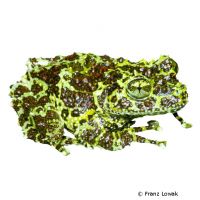Mossy Frog (Theloderma corticale)
| Mossy Frog Theloderma corticale | |
|---|---|
| Name | Mossy Frog |
| Name Lat. | Theloderma corticale |
| Family | Old World Tree Frogs |
| Family lat. | Rhacophoridae |
| Order | Frogs & Toads |
| Order lat. | Anura |
| Origin | Southeast Asia |
| Habitat | Mountain rainforest |
| Diet | Small live insects |
| Humidity | 70-90 % |
| Behavior | Peaceful, nocturnal |
| Keeping | Individual, pair, group |
| Care Level | Difficult |
| Breeding | Moderately difficult |
| Housing | Aquaterrarium |
| Life Span | 10 years |
| Protection | No |
| Metric Units | |
| Size | 8 cm |
| Temperature | 22-28 °C |
| Housing Size | 50 x 30 x 50 cm |
| US Units | |
| Size | 3.1" |
| Temperature | 72-82 °F |
| Housing Size | 20" x 10" x 20" |
Distribution and habitat
The nocturnal moss frogs originate from the mountain rainforests of northern Vietnam (Mao Son and Tam Dao mountains). There they inhabit tree hollows and rock crevices near bodies of water.
Maintenance
For 1-3 animals, the minimum area of the terrarium is 1,500 cm², 2/3 of which is the water part, with a minimum effective height (measured without substrate) of 4-15 cm. This corresponds to a base area of e.g. 50 x 30 cm. For each additional animal, an additional 300 cm² of space should be provided. The terrarium should be placed in a quiet place without sunlight.
The semi-aquatic animals need a terrarium with climbing branches, rock crevices, structured back and side walls (hiding places) as well as shade giving plants (Tradescantia, Ficus, Bromeliads). Potted plants that can be easily removed for cleaning are advantageous. The substrate must be loose, absorbent, non-rotting substrate such as a sand-peat-clean soil mixture or coconut fiber, and drainage to prevent siltation. They also need a planted water basin at least 10 cm deep with an air vent. The water quality must be that required for the average keeping of freshwater fish. At least twice a day, the inside of the terrarium must be finely sprayed with water (humidity), but a rain or mist system is better
| Temp. day: 22-28 °C | Temp. night: min. 21 °C | Humidity: 70-90 |
The lighting duration must be 10-14 hours depending on the season. Daylight fluorescent tubes with low UV content are very suitable, supplemented with spotlights.
Diet
The food supply consists of live insects such as flies, wax moths, house crickets, small grasshoppers and crickets as well as mealybug larvae and cockroaches. Food should be offered to adult animals 2-3 times a week, young animals must be fed daily. It is important to add minerals and vitamins regularly (e.g. by dusting the feed animals). The quality of the feed animals can be upgraded by feeding overripe fruit and honey water.
A varied diet promotes health and prevents deficiency symptoms.
Reproduction and breeding
Partners are found via alternating calls. The slightly larger female sticks her 11-37 eggs individually above a water surface on stones, leaves or branches. After 15 days the developed larvae (tadpoles) drop into the water, eat animal food and grow up to 60 mm in size. After about 60 days, the transformation (metamorphosis) is complete and the 20-23 mm frog leaves the water.
Important
During the day, the animals rest in the planted water basin. They have widened adhesive discs on the ends of their fingers and toes as a climbing aid. They owe their name to their coloration and skin structure, which is reminiscent of a moss-covered rock surface.
A resting period of approx. 2 months at a temperature of 13-18 °C is recommended.
Before purchase, a terrarium should be prepared that meets the species specific needs. Necessary are good ventilation without drafts and devices for measuring temperature and humidity. The lighting has to correspond to the species-specific day-night rhythm and should be placed in such a way that the animals cannot injure themselves. The terrarium should be locked in such a way that neither unauthorized persons can open it nor the animals can escape. Special attention must be paid to thorough hygiene and impurities must be removed regularly
Further literature can be found in your pet store.
References
Text: petdata; Image: Franz Lowak
Source: ENGELMANN (2006): Zootierhaltung - Tiere in menschlicher Obhut: Reptilien und Amphibien, Harri Deutsch Verlag; VDA & DGHT (2006): Haltungsrichtlinien für die Haltung von Anuren
- Gemäß § 21 Abs. 5 Tierschutzgesetz idgF
